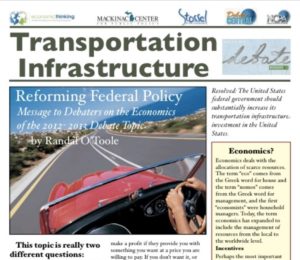Free Money for Freeways: Notes on Federal Transportation Reform
Billions are being invested upgrading U.S. railroads, including various new technologies. The federal government has little involvement in this upgrade. Railroad, apart from Amtrak, are privately owned and operated and when demand for services increases, or is projected to increase, infrastructure owners invest capital to expand capacity.
It’s not complicated. Or rather, it is complicated, but in the private sector with private ownership, transportation infrastructure decisions are business decisions rather than debate topics. For some reason, it is government-controlled transportation services and resources that keep turning up as debate topics. Why is that? Discussions and debates that would, in a market system, take place within companies and industries (about railroad infrastructure investments, for example), turn into political battles among various government agencies, politicians, and special interest groups when federal subsidies are available, or resources are government-owned or regulated (highways, freeways, bridges, and ports, for example).
For some reason, it is government-controlled transportation services and resources that keep turning up as debate topics. Why is that? Discussions and debates that would, in a market system, take place within companies and industries (about railroad infrastructure investments, for example), turn into political battles among various government agencies, politicians, and special interest groups when federal subsidies are available, or resources are government-owned or regulated (highways, freeways, bridges, and ports, for example).
Consider this meeting from a Yes, Minister episode to decide how best to manage and fund U.K. transportation infrastructure:
Each of these government transportation officials is lobbied by private firms and unions that supply goods and services, as well as by major construction firms that would like to build out major new infrastructure. The U.S. government owns and operates Amtrak, which loses millions of taxpayer dollars each year. Union workers lobby for higher pay and more jobs, and threaten strikes in response to efforts to lower pay or benefits or improve automation that would reduce jobs. Private firms that build or import railcars lobby and contribute to the campaigns of congressmen on committees that make the buying decisions.
Managers and investors in the current private U.S. railroad industry make the key decisions and take the key risks. Not Congressmen or state and federal agencies whose decisions put taxpayers’ money at risk. People who ship goods via railroads will pay fees and railroad firms use those fees to pay expenses as well as to pay investors via dividends or to pay interest on borrowing.
Federal highways airports, and ports, I would argue, would all be better managed by private firms, just as America’s freight railroads are. Then private firms would make decisions on expanding or otherwise upgrading stretches of freeways, or on building new ones, replacing or repairing bridges.
When these decisions are politically made, mismanagement and misdirected investment often results. I discuss these problems in the video notes in other posts, drawing from Randy O’Toole’s books Gridlock and Best-Laid Plans, as well as other transportation books and studies.
Debaters concerned with the hundreds of billions of dollars likely required for major improvements and expansions of highway infrastructure to reduce congestion can invoke some economic magic. It turns out that billions of transportation dollars go up in smoke each day. Call it the bonfire of the commons. Because freeways at rush hour lack pricing signals, there is no way to allocate scarce resources. With hotels and movie theaters, consumers face higher prices at times of peak demand. Hotel room prices and movie prices go up on busy Friday and Saturday evenings. People who have flexibility, go to movies at other times. New services like AirBnB provide alternatives to hotels.
Uber has “surge pricing” for times when demand is high. The Surge Prices encourage riders to wait a bit for prices to fall and higher prices encourage drivers to mobilize from home or other parts of town.
Similarly, surge pricing for freeways would encourage those who can to wait (studies have shown some 50% of drivers during rush hour aren’t going to or from work). And surge income can fund freeway expansion. Time story on congestion costs:
the researchers estimate that the combined annual price of traffic in the U.S. and Europe will soar to $293 billion by 2030, a rise of nearly 50% from 2013.
Here is a fun Drew Carey video for Reason on highway gridlock: “Gridlock: Hell on Wheels by Drew Carey and Reason.tv”

1 Response
[…] • Free Money for Freeways: Notes on Federal Transportation Reform (2017) […]